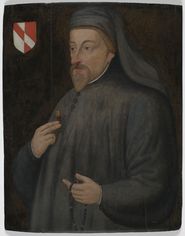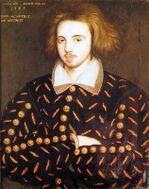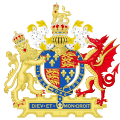عصر النهضة الإنجليزي

|
المواضيع
|
|
العمارة |
المناطق
|
|
إنگلترة |
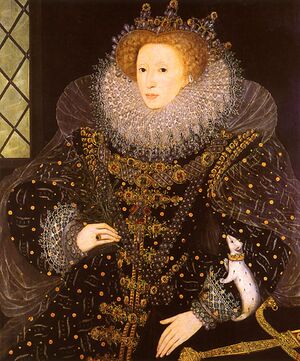
عصر النهضة الإنجليزي English Renaissance كان حركة ثقافية وفنية في إنگلترة من مطلع القرن 16 إلى مطلع القرن 17.[1] It is associated with the pan-European Renaissance that is usually regarded as beginning in Italy in the late 14th century. As in most of the rest of northern Europe, England saw little of these developments until more than a century later within the Northern Renaissance. Renaissance style and ideas were slow to penetrate England, and the Elizabethan era in the second half of the 16th century is usually regarded as the height of the English Renaissance. Many scholars see its beginnings in the early 16th century during the reign of Henry VIII.[2]
The English Renaissance is different from the Italian Renaissance in several ways. The dominant art forms of the English Renaissance were literature and music. Visual arts in the English Renaissance were much less significant than in the Italian Renaissance. The English period began far later than the Italian, which was moving into Mannerism and the Baroque by the 1550s or earlier.
الأدب
بدأت النهضة الأوربية في إيطاليا منذ أوائل القرن الخامس عشر، ولم يتسع انتشارها إلا بعد مضي قرن ونصف عليها، إذ كانت مسيرتها بطيئة في فرنسة وألمانية وإنكلترة، ومع إطلالة عصر النهضة في إنكلترة بلغت اللغة الإنكليزية بداية مرحلة الحداثة؛ وأصبحت لغة مختلفة عن لغة العصر الوسيط، ومع هذا فقد تطورت اللغة الإنكليزية في هذا العصر لتصبح لغة الأدب. ولكن اللاتينية ظلت مهيمنة على الحياة الفكرية. ويدعى هذا العصر في إنكلترة أيضاً بالعصر الإليزابيتي نسبة إلى الملكة إليزابيت الأولى مع أن النهضة في الأدب والفن بدأت قبل توليها العرش واستمرت بعد وفاتها وتولي الملك جيمس الأول العرش من بعدها.
يمتد عصر النهضة في إنكلترة على مدى ثلاثة قرون منذ أواخر القرن الخامس عشر حتى القرن السابع عشر. ومع أن المؤرخين يقسمون هذا العصر إلى عدة حقب في إنكلترة بحسب الملوك والحكام الذين توالوا على العرش خلال ثلاثة قرون، إلا أن التيار الأدبي الذي ساد كان واحداً تقريباً وهو العودة إلى الاتباعية القديمة التي تمثلها الحضارة اليونانية والرومانية. وانتشر بهذا مذهب الإنسانية الذي يجد في الإنسان مركزاً للكون وطاقة مستقلة بحد ذاتها. شهد هذا العصر تطوراً ملحوظاً في حياة المدن التي جذبت إليها ما صار يسمى بالطبقة الوسطى، وأدى تحرر الفرد من تبعية الكنيسة والإقطاع التي سادت في العصور الوسطى إلى انطلاقه في هذا العالم بحرية البحث والتفكير، حتى صارت الحرية الفردية موضع الاهتمام الأول عند الأديب، ولم يعد الأدب وقفاً على طبقة النبلاء، بل صار من أولويات الحياة عند أبناء الطبقة الوسطى، ومن هنا بدأ الاتجاه نحو الواقعية والتركيز على النواحي الروحية لدى الأفراد العاديين بدلاً من الاهتمام بسير النبلاء، وصارت الصبغة الإنسانية لدى الفرد العادي هي التي تميز صورة البطل في أدب العصر.
وقد تميزت الحقبة الأولى من هذا العصر، وهي حقبة آل تيودور قبل مجيء الملكة إليزابيت الأولى، بتأثير أكبر للحضارة الاتباعية وتحرر مفاجئ من تبعية الكنيسة الكاثوليكية، وقد سبب هذا الانفصال المفاجئ عن الكنيسة بعض الفوضى والضياع وعدم الاستقرار، ولكن ما لبثت إنكلترة أن بدأت تنعم بالحرية، وبدأت تتطور إلى بلد تجاري مستقل. وبدأ يظهر تأثير مذهب الإنسانية في الحياة بعيداً عن سيطرة الكنيسة. ولكن في ذلك الوقت كان الاعتماد في الأدب على الاقتباس والترجمة من الأدب الإيطالي والفرنسي، فترجم ويات وهنري هوارد السونيتات الإيطالية، وتميز توماس إليوت Thomas Elyot وتوماس مور في مجال الكتابة النثرية، وظهرت عدة محاولات لترجمة الكتاب المقدس إلى الإنكليزية أدت في البداية إلى إعدام بعض الكتّاب مثل تيندل Tyndale ومور إذ كانت هذه المحاولات من المحرمات. أما المسرح فكان في البداية امتداداً لمسرح العصور الوسطى، إذ بقيت المسرحيات الدينية والأخلاقية منتشرة حتى الحقبة الإليزابيتية.
ومع مجيء الملكة إليزابيت إلى الحكم عام 1558، وصلت إنكلترة قمة ازدهارها الاقتصادي والأدبي وأصبح المسرح والشعر في هذه الحقبة في أوج عظمته. وقد ظهرت في البداية نصوص مسرحية شعرية Poetic Drama تعالج حكايات السحر والفروسية اشتهر بها مجموعة من الكتّاب يُدعون «ظرفاء الجامعة» University Wits من أمثال روبرت گرين Robert Green وتوماس لودج Thomas Lodge وجورج بيل George Peele وتوماس ناش Thomas Nash، ولكن مسرحياتهم لم تتميز بالنضج المسرحي ولم تكن ملائمة للعرض المسرحي حتى تطور المسرح الإليزابيتي لاحقاً بعد بناء المسارح وقدم توماس كيد Thomas Kyd الذي عُرف بولعه بالمسرح مسرحيته المشهورة المأساة الإسبانية (1587) The Spanish Tragedy وهي مأساة تدور حول موضوع الانتقام الشائع آنذاك، إذ أثرت مسرحيته هذه في جميع الكتّاب الذين جاؤوا من بعده مثل كريستوفر مارلو Christopher Marlowe وشكسبير وبن جونسون Ben Jonson.
ومع أن المأساة كانت أكثر انتشاراً من الملهاة فقد ظهر في البداية نوع من الملهاة المبكرة التي كانت تدين بشيء ما للكتاب المسرحيين الرومان، واتخذت هذه المسرحيات صبغة ريفية، واعتمدت على أنماط من الشخصيات المضحكة المكررة. وتطور بعد هذا نوع أكثر صقلاً من الملهاة في البلاط الملكي نفسه كان يقدمها أمام الملكة تلامذة المدارس الثانوية Grammar Schools التي كانت تدرّس اليونانية واللاتينية، وامتازت هذه المسرحيات بأسلوب نثري متقن ومتأنق بلاغياً، وأهم الكتاب في هذا المجال هو جون ليلي John Lyly ومسرحياته التي اشتهر بها مثل مسرحية أوفيوس (1579) Euphues.
وقد كان مارلو أول من استخدم الشعر الحر في مسرحياته فحرر بذلك المسرح من قيود القوافي الشعرية والبلاغة المتأنقة ومهد الطريق أمام شكسبير الذي يعد إلى اليوم أهم الشعراء والكتاب المسرحيين الإنگليز والعالميين، وما تزال نصوصه المسرحية التي تبلغ أكثر من ست وثلاثين مسرحية تسحر القراء ورجال المسرح. وقد تميز عصر شكسبير أو العصر الإليزابيتي بتشييد الكثير من المسارح العامة بعد أن كان الممثلون يقدمون عروضهم في الفنادق والحانات التي كانت منتشرة على الطرق المؤدية إلى لندن. وبازدياد عدد المسارح تزايد عدد النصوص المسرحية لتجعل من العصر الإليزابيتي من أغنى عصور إنكلترة مسرحياً.
وتميز العصر أيضاً بظهور بعض الشعراء الذين كتبوا الكثير من الأشعار الغنائية ومن أهمهم والتر رالي Walter Raleig وصموئيل دانييل Samuel Daniel وإدموند سبنسر Edmund Spenser وفيليب سيدني Philip Sidney ومايكل دريتون Michael Drayton وتعد رائعة سبنسر ملكة الجن The Faerie Queene ( 1590 ) في أهم ما كتب في الشعر الإنگليزي.
أما في الحقبة الثالثة من عصر النهضة، وهي الحقبة اليعقوبية خلال حكم الملك جيمس الأول، فقد كانت في بدايتها امتداداً لازدهار الحقبة الإليزابيتية إذ كتب شكسبير أهم مسرحياته في أواخر حياته، وكذلك جون ويبستر John Webster وبومونت وفليتشر وبن جونسون وتوماس ميدلتون Thomas Middleton. ولكن انتشرت بعد هذا الروح السوداوية للانحطاط السياسي واتساع هوة الخلاف بين البيوريتانيين (التطهريين) Puritans والنبلاء. وطغت الواقعية الساخرة في الأعمال الأدبية وظهرت بشكل واضح في أعمال توماس ميدلتون و ويبستر و بن جونسون وفي أعمال شكسبير الأخيرة، وظهرت أيضاً في بدايات شعر جون دن John Donne ودرايتون واستمرت هذه الروح السوداوية الساخرة في عصر الملك شارل الأول الذي كان امتداداً لما سبقه أيضاً، ولكن بدأ البيوريتانيون فرض سيطرتهم على إنگلترا وأغلقت المسارح عام 1642 بسبب الحرب الأهلية التي كانت نتيجتها أن استولى الجنرال كرومويل على السلطة بعد أن أقصى الملك شارل الأول عن الحكم وحكم بريطانية من عام 1653 حتى 1658. ووضع البيوريتانيون قيودهم على النشاط الأدبي وأغلقوا المسارح خلال حقبة الكومنولث حتى عام 1660. فأفل نجم أدب عصر النهضة ومسرحه تاركاً وراءه تأثير الاتباعية ليمهد لمولد اتباعية جديدة Neo-Classicism في العصر الذي تلاه مباشرة، ولم يظهر في الأدب ما يستحق الاهتمام سوى ملحمة جون ميلتون John Milton الشعرية الفردوس المفقود Paradise Lost وغيرها من الكتابات السياسية التي كتبها في أثناء عمله مساعداً لكرومويل.
الفنون المرئية
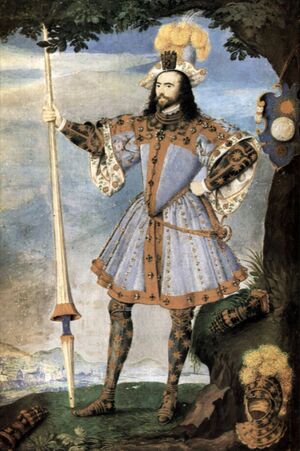
England was slow to produce visual arts in Renaissance styles, and the artists of the Tudor court were mainly imported foreigners until after the end of the Renaissance; Hans Holbein was the outstanding figure. The English Reformation produced a huge programme of iconoclasm that destroyed almost all medieval religious art, and all but ended the skill of painting in England; English art was to be dominated by portrait painting, and then later landscape art, for centuries to come.
The significant English invention was the portrait miniature, which essentially took the techniques of the dying art of the illuminated manuscript and transferred them to small portraits worn in lockets. Though the form was developed in England by foreign artists, mostly Flemish like Lucas Horenbout, the somewhat undistinguished founder of the tradition, by the late 16th century natives such as Nicolas Hilliard and Isaac Oliver produced the finest work, even as the best producers of larger portraits in oil were still foreigners. The portrait miniature had spread all over Europe by the 18th century.
The portraiture of Elizabeth I was carefully controlled and developed into an elaborate and wholly un-realist iconic style, that has succeeded in creating enduring images. The many portraits drove the evolution of English royal portraits in the Early Modern period. Even the earliest portraits of Elizabeth I contain symbolic objects such as roses and prayer books that would have carried meaning to viewers of her day. Later portraits of Elizabeth layer the iconography of empire—globes, crowns, swords and columns—and representations of virginity and purity—such as moons and pearls—with classical allusions to present a complex "story" that conveyed to Elizabethan era viewers the majesty and significance of their Virgin Queen. The Armada Portrait is an allegorical panel painting depicting the queen surrounded by symbols of empire against a backdrop representing the defeat of the Spanish Armada in 1588.
الموسيقى
موسيقى عصر النهضة الإنجليزي kept in touch with continental developments far more than visual art, and managed to survive the Reformation relatively successfully, though William Byrd (c.1539/40 or 1543 – 1623) and other major figures were Catholic. The Elizabethan madrigal was distinct from, but related to, the Italian tradition. Thomas Tallis, (c.1505 –1585 Thomas Morley (1557 or 1558 – 1602)), and John Dowland (1563 – 1626) were other leading English composers.
The key composers from the early Renaissance era also wrote in a late Medieval style, and as such, they are transitional figures. Leonel Power (c. 1370s or 1380s–1445) was an English composer of the late medieval and early Renaissance music eras. Along with John Dunstaple, he was one of the major figures in English music in the early 15th century.[3][4] Power is the composer best represented in the Old Hall Manuscript. Power was one of the first composers to set separate movements of the ordinary of the mass which were thematically unified and intended for contiguous performance. The Old Hall Manuscript contains his mass based on the Marian antiphon, Alma Redemptoris Mater, in which the antiphon is stated literally in the tenor voice in each movement, without melodic ornaments. This is the only cyclic setting of the mass ordinary which can be attributed to him.[5] He wrote mass cycles, fragments, and single movements and a variety of other sacred works.
John Dunstaple (or Dunstable) (c. 1390–1453) was an English composer of polyphonic music of the late medieval era and early Renaissance periods. He was one of the most famous composers active in the early 15th century, a near-contemporary of Power, and was widely influential, not only in England but on the continent, especially in the developing style of the Burgundian School. Dunstaple's influence on the continent's musical vocabulary was enormous, particularly considering the relative paucity of his (attributable) works. He was recognized for possessing something never heard before in music of the Burgundian School: la contenance angloise ("the English countenance"), a term used by the poet Martin le Franc in his Le Champion des Dames.
The colossal polychoral productions of the Venetian School had been anticipated in the works of Thomas Tallis, and the Palestrina style from the Roman School had already been absorbed prior to the publication of Musica transalpina, in the music of masters such as William Byrd.
The Italian and English Renaissances were similar in sharing a specific musical aesthetic. In the late 16th century Italy was the musical center of Europe, and one of the principal forms which emerged from that singular explosion of musical creativity was the madrigal. In 1588, Nicholas Yonge published in England the Musica transalpina—a collection of Italian madrigals that had been Anglicized—an event which began a vogue of madrigal in England which was almost unmatched in the Renaissance in being an instantaneous adoption of an idea, from another country, adapted to local aesthetics. English poetry was exactly at the right stage of development for this transplantation to occur, since forms such as the sonnet were uniquely adapted to setting as madrigals; indeed, the sonnet was already well developed in Italy. Composers such as Thomas Morley, the only contemporary composer to set Shakespeare, and whose work survives, published collections of their own, roughly in the Italian manner but yet with a unique Englishness; interest in the compositions of the English Madrigal School has enjoyed a considerable revival in recent decades.
العمارة
Despite some buildings in a partly Renaissance style from the reign of Henry VIII (1491 – 1547), notably Hampton Court Palace (begun in 1515), the vanished Nonsuch Palace, Sutton Place and Layer Marney Tower, it was not until the Elizabethan architecture of the end of the century that a true Renaissance style emerged. The wool trade, which had carried the economic life of England in the late medieval period, was no longer as prosperous as it had been and there was less disposable wealth for architectural projects. Under Elizabeth, farming was encouraged resulting in a recovery that put a vast amount of wealth into the hands of a large number of people. Elizabeth built no new palaces, instead encouraging her courtiers to build extravagantly and house her on her summer progresses. A large number of small houses were built, and at the same time many country mansions were constructed. Many of the earlier medieval or Tudor manors were remodelled and modernised during Elizabeth's reign. Civic and institutional buildings were also becoming increasingly common.[6]
The most famous buildings, of a type called the prodigy house, are large show houses constructed for courtiers, and characterised by lavish use of glass, as at "Hardwick Hall, more glass than wall", Wollaton Hall, Montacute House, Hatfield House and Burghley House, the style continuing into the early 17th century before developing into Jacobean architecture. Lesser, but still large, houses like Little Moreton Hall continued to be constructed and expanded in essentially medieval half-timbered styles until the late 16th century. Church architecture essentially continued in the late medieval Perpendicular Gothic style until the Reformation, and then stopped almost completely, although church monuments, screens and other fittings often had classical styles from about the mid-century. The few new church buildings post-Reformation were usually still Gothic in style, as in Langley Chapel of 1601.[7]
It was also at this time that the long gallery became popular in English manor houses, often displaying painting collections and decorated ceilings. This was apparently mainly used for walking in, and a growing range of parlours and withdrawing rooms supplemented the main living room for the family, the great chamber. The great hall was now mostly used by the servants, and as an impressive point of entry to the house.[6]
المؤلفون الكبار في عصر النهضة الإنجليزي
Major literary figures in the English Renaissance include:
- فرانسيس بيكون
- Francis Beaumont
- Thomas Campion
- George Chapman
- Francis Hubert
- Thomas Dekker
- John Donne
- John Fletcher
- John Ford
- John Milton
- Ben Jonson
- Thomas Kyd
- Christopher Marlowe
- Philip Massinger
- Thomas Middleton
- Thomas More
- Thomas Nashe
- William Rowley
- William Shakespeare
- James Shirley
- Philip Sidney
- Edmund Spenser
- William Tyndale
- John Webster
- Thomas Wyatt
انظر أيضاً
المراجع
- ^ Key features of Renaissance culture Andrew Dickson, "An English Renaissance: Key features of Renaissance culture". British Library online, 2017
- ^ "English Renaissance", Poetry Foundation online
- ^ Stolba 1990, p. 140.
- ^ Emmerson and Clayton-Emmerson 2006, 544.
- ^ Bent n.d..
- ^ أ ب "Architectural Style : Tudor and Elizabethan". www.buildinghistory.org. Retrieved 2021-05-01.
- ^ Airs, Malcolm, The Buildings of Britain, A Guide and Gazetteer, Tudor and Jacobean, especially chapters 1, 3 and 8, 1982, Barrie & Jenkins (London), ISBN 0-09-147831-6
الأعمال المذكورة
- Bent, Margaret. "Power, Leonel". Grove Music Online, edited by Deane Root. S.l.: Oxford Music Online, n.d. (accessed June 23, 2015).
- Emmerson, Richard Kenneth, and Sandra Clayton-Emmerson. Key Figures in Medieval Europe: An Encyclopedia. [New York?]: Routledge, 2006. ISBN 978-0-415-97385-4
- Rogers, Pat (2001). The Oxford illustrated history of English literature. Oxford University Press. ISBN 978-0-19-285437-7.
- Rowse, A. L. (1971). Elizabethan Renaissance. Scribner. ISBN 978-0-684-12682-1.
- Stolba, Marie (1990). The Development of Western Music: A History. Dubuque: W.C. Brown. ISBN 978-0-697-00182-5.
Leonel Power (c. 1375–1445) was one of the two leading composers of English music between 1410 and 1445. The other was John Dunstaple.
للاستزادة
- Cheney, Patrick. "Recent Studies in the English Renaissance," SEL: Studies In English Literature (2007) 47(1): 199-275
- Grant, Patrick. 1979. Images and Ideas in the Literature of the English Renaissance. Amherst: University of Massachusetts Press.
- Hadfield, Andrew. The English Renaissance, 1500-1620 (2001)
- Hattaway, Michael, ed. A Companion to English Renaissance Literature and Culture. (2000). 747 pp.
- Keenan, Siobhan. Renaissance Literature (Edinburgh Critical Guides to Literature) (2008)
- Lamb, Mary Ellen. "Recent Studies In The English Renaissance," SEL: Studies in English Literature (Johns Hopkins); 2006 46(1): 195-252
- Loewenstein, David. "Recent Studies in the English Renaissance," SEL: Studies in English Literature Spring 2011, Vol. 51 Issue 2, pp 199–278
- Robin, Diana; Larsen, Anne R.; and Levin, Carole, eds. Encyclopedia of Women in the Renaissance: Italy, France, and England (2007) 459p.
- Sheen, Erica, and Lorna Hutson, eds. Literature, Politics and Law in Renaissance England (2005)
- Smith, Emma and Garrett A. Sullivan Jr., eds. The Cambridge Companion to English Renaissance Tragedy (2010)
- Wynne-Davies, Marion. Women Writers and Familial Discourse in the English Renaissance. Relative Values (2007)
- Short description is different from Wikidata
- Pages using multiple image with manual scaled images
- Articles with hatnote templates targeting a nonexistent page
- عصر النهضة الإنجليزي
- Renaissance
- Northern Renaissance
- Renaissance architecture in England
- التاريخ الثقافي لإنجلترة
- Stuart England
- Tudor England
- 15th century in England
- 16th century in England
- 17th century in England
- History of England by period
- History of the United Kingdom by period
- مملكة إنجلترة
